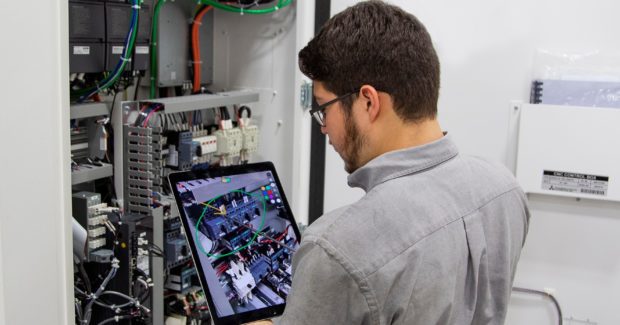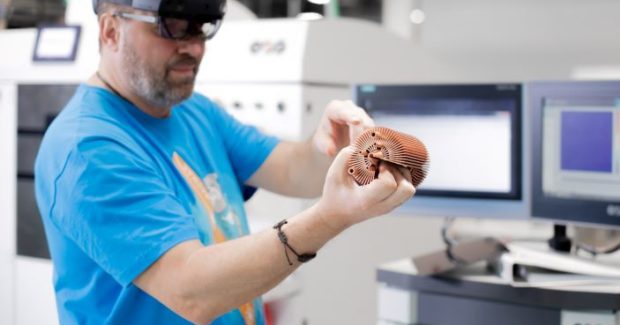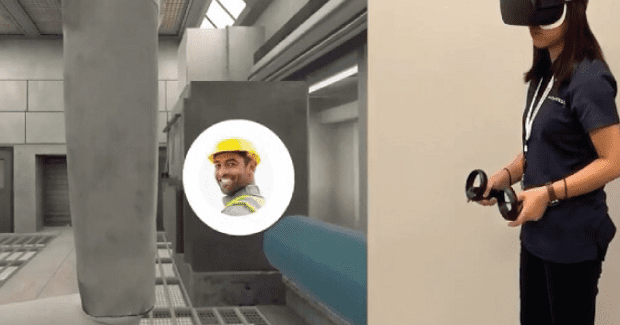Can You See Me? Augmented Reality for Maintenance and Training
By utilizing AR or VR, users with headsets or with smart glasses or smartphones can learn how to maintain machinery or troubleshoot pieces of machinery.
Posted: December 16, 2021
COVER STORY
By Rachel Duran
The use of augmented reality (AR) or virtual reality (VR) for maintenance and repairs and workforce training in the manufacturing sector has increasingly gained popularity, receiving a boost during the national shutdown at the height of the pandemic when it was necessary to keep everyone in place at the shop and not on the road traveling to offsite training spots or to physical machines to conduct maintenance.
SIMULATIONS PUT YOU IN CONTROL
What are the differences between VR and AR? VR involves a headset that takes over what you see and blocks out your surroundings. AR involves a pair of smart glasses or smartphone or tablet where you can see everything in front of you, but images are projected over what you see.
For example, with AR a digital overlay of equipment is created, and operators can immediately troubleshoot issues with technicians and experts located offsite anywhere in the world, versus waiting for a technician to arrive at the shop, avoiding costly machine shutdowns. Operators no longer need to consult a large, clunky or outdated service manual because the digital overlay on the machines allows them to find the exact information they need.
Mazak Corp. offers customers the MPower support program, which includes expert technical service through the Remote Assist Service, and on-demand training that offers online and virtual experiences as part of its Learning Management System. Mazak is a leader in the design and manufacture of machine tool solutions, based in Florence, Ky.
With the Remote Assist Service, a customer downloads a mobile or web app and connects with a technician, who is located at one of Mazak’s Technology Centers, Technical Centers or its headquarters in Florence. The technician interacts with the shop’s connected devices to send work instructions and communicate with the shop just as in a face-to-face service call.
In addition to saving on the costs of an in-person service call, the process can eliminate an in-person diagnostics visit before the parts order, saving an average of two days of downtime, according to Mazak. The Remote Assist not only combines diagnostics and part orders into one virtual visit, but it also offers three-way connections where service technicians can collaborate with other experts on solutions.
A TRAINING AND RECRUITMENT TOOL
For Mazda Toyota Manufacturing in Huntsville, Ala., sending people offsite to train at specific facilities on specialized advanced robots was challenging during COVID when travel schedules were dramatically reduced. “If you do not have a training facility, a classroom, equipment with the robots, you can’t really do the training,” said Bharani Rajakumar, CEO of TRANSFR Inc., New York, N.Y. The company offers skilled trades VR training, which includes welding and robotic safety.
“So, this was an instance where having the virtual training really helped to ensure that training could proceed,” Rajakumar said. “People could do hands-on training in virtual reality while they were waiting for the physical equipment to arrive.” The simulated training was preparing “robot doctors” to maintain paint robots at Mazda Toyota.
How does the VR training work? In brief, using TRANSFR’s process as an example, trainees put on a headset and are transported to a virtual training facility and participate in pre-apprenticeship training. A digital coach walks the trainee through the training, providing instruction and pointing out mistakes so when the trainee removes the headset, they can perform these skills in front of a hiring manager.
The VR programming assisted Mazda Toyota in creating a talent pipeline, effectively upskilling trainees’ capabilities, as well as providing a learning environment that boosted the confidence of trainees. And for the company, at a practical level, the simulated training helps scale the ability to train, Rajakumar noted. “There are a limited number of trainers out there that have the specialized skills and expertise to pass that information on to the next generation of workers in manufacturing skill trades,” he said.
The benefits of VR training gained the attention of the Manufacturing Institute, part of the National Association of Manufacturers. The Manufacturing Institute called on TRANSFR to assist with training initiatives as part of the Heroes MAKE America program, which is a training program to prepare veterans to enter the workforce and civilian life. “The relationship with the Manufacturing Institute was innovative in a couple of ways because we were working with a nontraditional learner, not a high school or two-year college student,” Rajakumar stated. And the members of this specific population could be located anywhere in the world. Initially, the VR training was conducted from a couple of two-year college sites.
The Manufacturing Institute is now exploring how to scale the model beyond physical classroom limitations and enable people to train from the comfort of their homes or from military bases anywhere in the world. “They can acquire the skills and be prepared for the interview before they even get an interview,” Rajakumar said.
SHIFTING PERCEPTIONS
A side benefit to the training developed for Mazda Toyota was the exposure about robot doctor jobs to other audiences such as the K-12 and the higher education systems. Rajakumar said the simulated training becomes a recruiting tool as well. “This is what helps resolve the key issue the industry is facing; there are a lot of jobs and not enough applicants,” he said. “It attracts people to the industry that might think manufacturing is all about smokestacks when the reality is that it is one of the most high-tech industries in the world.”
Schart pointed out another advantage for management by using simulation for training. The younger generation, digital natives as they are called, exploring careers in manufacturing are coming into a very traditional industry. “You need to attract them somehow because otherwise they will go to Google, Apple, Tesla — AR is something they [management] can use to solve the skills gap and solve the talent issues they have to lure the talent away from these companies and become attractive again,” said Dirk Schart, CMO and president, RE’FLEKT. The company, based in Sunnyvale, Calif., is an enterprise AR software company.
Manufacturing companies are more receptive to using augmented and virtual reality for training and maintenance as more organizations share their successful experiences. More than 100 global companies such as ABB, Bosch and Siemens use RE’FLEKT’s work augmentation and remote collaboration tools. The company deploys visual guidance, real-time information and remote collaboration.
RE’FLEKT focuses on the automotive, transportation and heavy machinery, medical devices and pharma industries. “From the value chain we start with the assembly, the product launch and go to the service and maintenance part, including training,” Schart said. “One of the topics we recently added is inspection and quality assurance. This is a hot topic, besides training.”
Manufacturing companies vary as to how much and what levels of training they provide through AR and VR. There isn’t a typical process — some companies want to concentrate on an early learning phase, or some want to provide training “nuggets.” Schart said for a manufacturer of 3D printers, EOS in Germany, the company wants to simulate points in the training journey. So, trainees can go directly to a training nugget.
By starting with training nuggets, manufacturers benefit from AR and VR technologies, not because of the technologies, but because they bring value and are easy to work with. “It really starts with making it accessible and not having a huge project,” Schart said. “The tech is not important. It is about the usability and making their (manufacturers) lives easier; making work easier and more fun.”
Added Rajakumar: “I think the key learning from the last year is if you can inspire and tap into someone’s own personal motivation to be successful, they are more likely to want to train and want to come and work for you. And that is a great benefit in terms of building the capacity for the future generation of skilled trade workers.”














